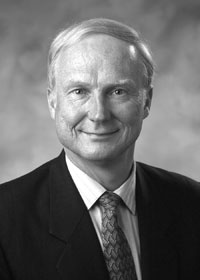Dr. Edward G. Tiedemann, Jr.
Senior Vice President, Engineering
QUALCOMM, Incorporated
MSEE 1977

When I finally joined Qualcomm in 1988, little did I know that this small company would end up at the forefront of cellular communications by pioneering using CDMA for cellular communications.
During his first year at Purdue, Ed Tiedemann became involved in research that led to an MS project in bandwidth efficient modulation with Professor Cooper. "I had a very productive relationship with George Cooper," Tiedemann recalls. "At the time, he had a program on spread spectrum cellular communications—I must have subconsciously learned some of these concepts. While I took courses and have memorable experiences working with other faculty members, George Cooper remains in my mind the person most responsible for starting me on the path towards developing insight into communications theory."
Thinking back to the beginning of his career, Tiedemann says, "In 1986, I had lunch at a small Chinese restaurant in Cambridge, Massachusetts, with Andy Viterbi, who, with Irwin Jacobs, had just started Qualcomm. Andy suggested that I consider joining Qualcomm. When I finally joined Qualcomm in 1988, little did I know that this small company would end up at the forefront of cellular communications by pioneering using CDMA for cellular communications. Little did I know that I would end up leading many of the industry activities in cellular communications."
After several years at Qualcomm, the initial concepts of CDMA cellular communications were proven and Tiedemann became involved in the system design for the CDMA air interface. Being one of the few people at Qualcomm that had an understanding of communication system design above the physical layer, he initially concentrated on the upper layer design of the air interface. A few months later, while others were busy building a trial system, he assumed the responsibility for enhancements to the CDMA air interface design. After successful field trials of the system in the fall of 1991, he put together and led a team to pursue standardization of CDMA.
After several years at Qualcomm, the initial concepts of CDMA cellular communications were proven and Tiedemann became involved in the system design for the CDMA air interface. Being one of the few people at Qualcomm that had an understanding of communication system design above the physical layer, he initially concentrated on the upper layer design of the air interface. A few months later, while others were busy building a trial system, he assumed the responsibility for enhancements to the CDMA air interface design. After successful field trials of the system in the fall of 1991, he put together and led a team to pursue standardization of CDMA.
Tiedemann was appointed Chair for the group in the Telecommunications Industry Association (TIA) that was responsible for the CDMA physical layer. This work resulted in the CDMA standard for cellular communications, IS-95. A few years later, when the U.S. Government opened up Personal Communications Systems (PCS), he led the industry work that was responsible for the CDMA PCS standard.
In the mid 1990s, when companies were starting to seriously think about third generation wireless systems, an initiative of the International Telecommunications Union (ITU), Tiedemann formed a small team that worked out many of the initial technical concepts for third generation CDMA wireless systems. This was successful for cdma2000, which was based upon the IS-95 standard. However, different business interests in other parts of the world created a clash of views, which led to what some called the 3G wars. When things settled, two main third generation CDMA standards emerged: cdma2000, standardized by 3GPP2; and UMTS, standardized by 3GPP. While there are many differences, both are based upon the same basic CDMA cellular concepts.
Today Tiedemann leads Qualcomm’s worldwide standardization activities and continues in his role as Chair of the standards group responsible for the cdma2000 physical layer. He is interested in many wireless system issues including adaptive antennas, handoff, power control, control of CDMA random access channels, and the tracking and paging of mobile users. Prior to becoming involved with terrestrial wireless communications, he was involved with numerous commercial and military satellite programs.
Today Tiedemann leads Qualcomm’s worldwide standardization activities and continues in his role as Chair of the standards group responsible for the cdma2000 physical layer. He is interested in many wireless system issues including adaptive antennas, handoff, power control, control of CDMA random access channels, and the tracking and paging of mobile users. Prior to becoming involved with terrestrial wireless communications, he was involved with numerous commercial and military satellite programs.
Despite a full schedule, Tiedemann makes time for other interests. "About three years ago, I decided to pursue my interest in old houses and purchased a 300-year-old house in Concord, Massachusetts," he says. "In 1775, the Acton minutemen marched in front of this house en route to fighting the first battle of the American Revolution; they still march past every year to the reenactment." Now he splits his time between Concord, San Diego, and various industry meetings, regularly traveling about 150,000 miles every year.
